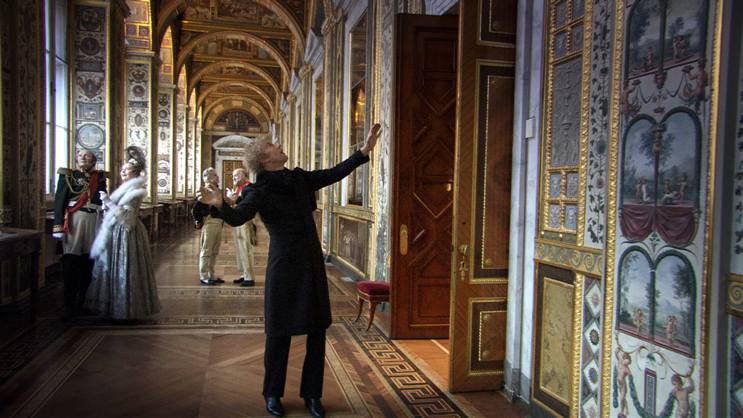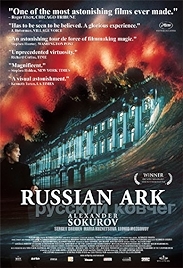A movie for every day of the year – a good one
18 May
International Museum Day
Today is International Museum Day, held annually by museum professionals as a way of highlighting the work that museums do in preserving the past. It was created in 1977 and has gained in popularity ever since, participating numbers rising from 20,000 museums in 2009 to 30,000 in 2012. Each year a theme is chosen: in 2002 it was “Museums and Globalisation”; in 1993 it was “Museums and Indigenous Peoples”. In 2012, the organisers, the International Council of Museums, encouraged people to take selfies of themselves at their local museum, under the rubric “Me and My Museum”.
Russian Ark (2002, dir: Aleksandr Sokurov)
Aleksandr Sokurov, bubbling under in art-crit terms for a number of years, almost became mainstream-popular when he released this film. It’s nothing more than a tour around the Hermitage Museum in St Petersburg, Russia. But what a film, what a tour. Sokurov decided the time had come, that the technology was there, to do the whole thing in one take. And so, using the exemplary Steadicam talents of Tilman Büttner (of Run Lola Run fame), and the Sony Cine-Alta HDW-F900 digital camera, plus thousands of extras, he sets off on a journey which glides us through the Hermitage from beginning to end. No edits, no handy pauses behind dark sofas or convenient walls, which was what Hitchcock was forced to do in Rope, his “one take” movie.
Sokurov and his small army of technicians, large army of actors, had only been given the Hermitage for four hours and so, having rehearsed for months beforehand, off they set on what must be the last word in one-shot movies. The film opens with an intertitle on which are written the words “I open my eyes and I see nothing”. And suddenly we do see something, a man introduced as the Marquis (Sergey Dreyden), a French diplomat from the 19th century who will be our guide round three centuries of art in one of the great collections in the world. Meanwhile, behind the camera, we can also hear the whispered commentary of Sokurov, questioning, challenging the rather snotty Marquis’s frequently scathing version of events and opinions on Russian culture.
The extras form a moving tableau, and the Marquis fills in some of the gaps in our knowledge: there’s Catherine the Great, here’s Nicholas I, suddenly we’re in a vast grand hall where a ball is taking place to the music of a symphony orchestra. It’s the last royal ball, we hear, before the revolution swept everything away. The camera glides on and through, up and beyond, as much a metaphor – the unbroken march of progress, in spite of setbacks such as the brutality of Stalin – as a triumph of technical achievement. Otherwise, there is no plot, no “arc” to borrow a homophone, and in some people’s eyes this is a failing.
Certainly, you might not watch Russian Ark more than once. But once is enough, quite honestly. It will make an impression, both in terms of the art on display on the walls and the cinematographic artistry. And it’s a forceful reminder that, until the creation of the Soviet Union, Russia was a European-facing power, whose rulers spoke French, German and English, whose art collections reflected this – watch as the Marquis pauses on the threshold of a room containing pictures from the 1930s, then declines to enter.
If Sokurov is telling us anything in this film he describes as “a single breath”, it’s that Russia changed permanently under the Soviets. The old Russia and its concerns are contained in the Hermitage, in this Ark. Poignantly, it lives there still, and this gliding, dreamlike film is Sokurov’s lament for the loss.
Why Watch?
- A unique event-movie
- Tilman Büttner’s amazing Steadicam work
- The marshalling of the actors
- Is the one take a gimmick or a genius idea?
Russian Ark – at Amazon
I am an Amazon affiliate
© Steve Morrissey 2014

